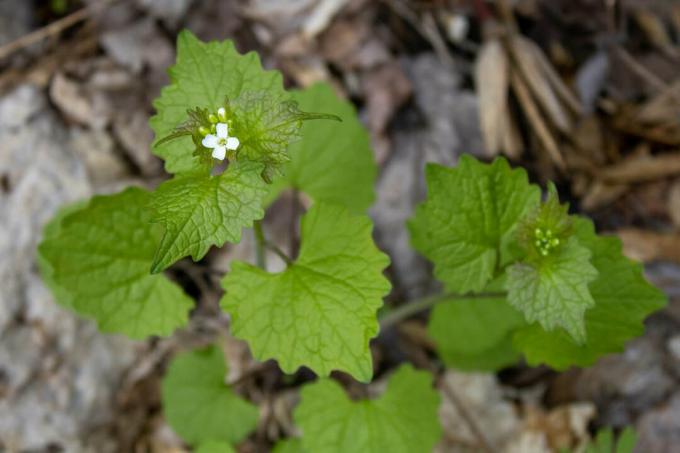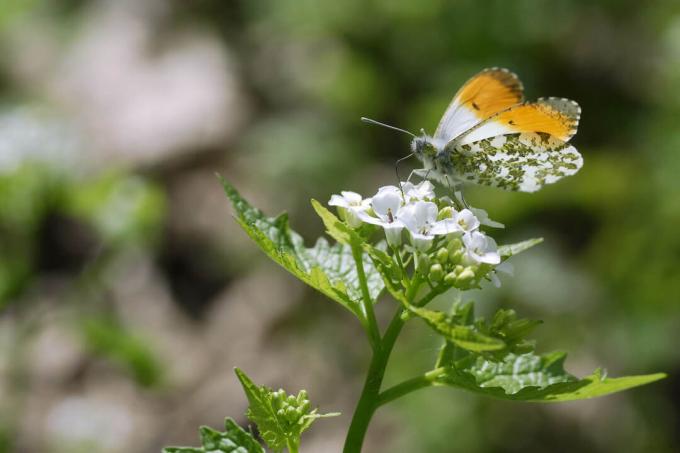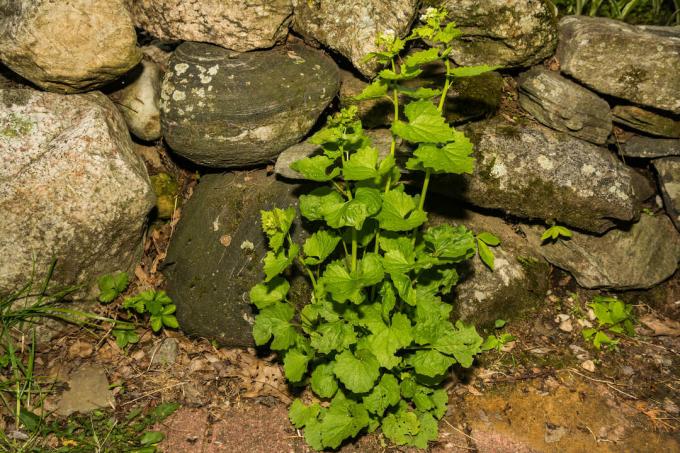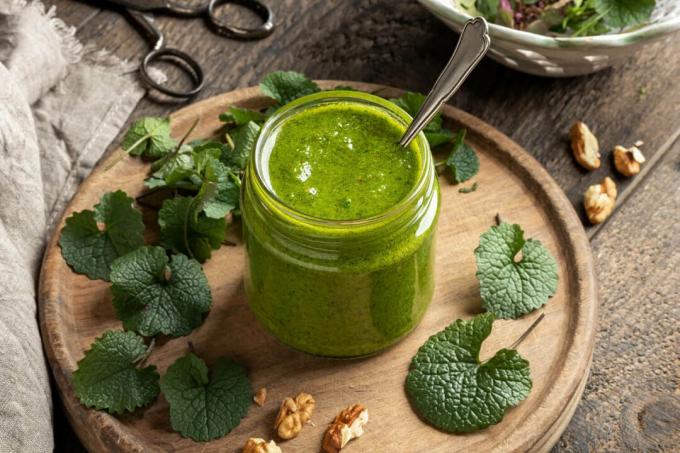Garlic mustard has been used as a medicinal and culinary herb for thousands of years. However, the aromatic herb is not an onion plant and therefore does not leave a typical taste and smell in the mouth.

Garlic herb (Alliaria petiolata) often encountered. It can be used in many ways in the kitchen because the leaves taste slightly of pepper and garlic. They can be harvested as early as March. Here you can find out how to grow it in the garden and what you need to look out for when caring for the garlic mustard.
contents
- Garlic mustard: flowering, origin and properties
- Planting garlic mustard: location and procedure
- The right care
- Propagation of garlic mustard
- Is the garlic mustard edible?
- Uses and side effects of garlic mustard
Garlic mustard: flowering, origin and properties
The garlic mustard (Alliaria petiolata) is a biennial to perennial herb of the cruciferous family (Brassicaceae). The kitchen and medicinal herb is also known under the names of garlic herb, leek herb or garlic wildflower. The plants are native to all of Europe, Central Asia and North Africa and also occur as an invasive species in North and South America. The garlic mustard often grows in shady deciduous forests, on nitrogen-rich soil. The garlic herb grows 20 to 100 cm tall and has a deep taproot. The alternately arranged leaves can have a diameter of up to 10 cm and are notched at the edge. The low-lying leaves are almost round with a distinctive indentation, higher-growing leaves taper to a point. When crushed, a typical smell is produced that is reminiscent of garlic and gives the herb its name. Between April and July many small, white, fourfold flowers appear in clusters. In spring and summer, they serve as a source of nectar for many insects and native butterflies. In summer, the flowers develop into elongated pods containing several small, black seeds.

Risk of confusion with the garlic mustard: The garlic mustard is difficult to confuse. The leaves of garlic mustard smell faintly of garlic, mustard and pepper when crushed. Groundman (Glechoma hederacea) only has a similar leaf shape, but the leaves are much smaller.
Planting garlic mustard: location and procedure
Garlic herb prefers a shady to half-shady location and thrives well next to trees, shrubs and hedges. The soil should be permeable, humic and nutrient-rich and have a neutral pH. Acidic soil needs to be fertilized with lime to raise the pH. If your soil is very clayey or sandy, we recommend improving it with a good quality potting soil. Our Plantura organic universal soil For example, the herb provides all the necessary nutrients and stores enough water - and it's completely peat-free.
You can sow the garlic mustard directly as seeds or use young plants. The plants are cold germinator and need exposure to cold to become germinable. For this reason, the garlic herb is not suitable for growing on the windowsill. Seeds should be sown directly outdoors between October and February.

Sow garlic mustard:
- Prepare the bed or pot for sowing: all plants are removed and very sandy or clayey soil is improved with plenty of nutrient-rich potting soil or compost. A shady place should be chosen for germination.
- The place should be marked so that the spot can still be found in spring.
- Now spread the seeds about 15 x 15 cm apart. The seeds should be about 1 cm deep and completely covered.
- The seed does not need to be watered and will germinate the following spring.
Tip: The garlic herb is also suitable for cultivation in the bucket. For this, the pot is filled with a loose and nutrient-rich potting soil, like ours Plantura organic universal soil, filled. Then the seeds are sown. The pot should simply be left outside in winter. From March it is advisable to keep the substrate moist.

The right care
In autumn and spring, the area should be freed from weeds that compete with the garlic mustard. From March onwards, keep the soil permanently moist. Plants must be watered during long periods of drought. In the second year and the following years, a dose of organic fertilizer is advantageous, since garlic mustard requires a particularly large amount of nitrogen. Our Plantura organic universal fertilizer is nitrogenous and releases the fertilizing effect over a period of at least three months. Work some of the fertilizer into the soil in spring.
Propagation of garlic mustard
Once the garlic mustard grows in the garden, it will multiply there by itself. Seeds form after the second year. These are then distributed in the area and begin to grow in the following years. At the beginning there are usually only a few plants, but after a few years the area is fully occupied by garlic wildflowers. In order to specifically harvest the seeds, you have to remove the pods in order to then get to the seeds inside. When they change color from green to brown, they can be cut off with scissors. The pods are then opened and collected over a bowl. After a few days of drying in the open air, the seeds can be stored in a dark jar in a cool place.

Is the garlic mustard edible?
All parts of the garlic mustard are edible. The easiest way is to use the leaves, which can be harvested from March. Young ones are more aromatic than old ones. The roots can also be eaten. The seeds taste the most intense. The taste of garlic mustard is reminiscent of garlic, mustard and pepper.
Uses and side effects of garlic mustard
The leaves, seeds and roots of the garlic herb have long been used in naturopathy as a tea or ointment. The plants contain, among other things, mustard oil glycosides, saponins and essential oils that are expectorant and antibacterial. The leaves are used in many ways in the kitchen. The garlic mustard refines salads, dips, pestos and many other dishes. However, the leaves and roots should not be dried, as this will lose the taste. In times when spices were priceless, the wild herb was a popular alternative for seasoning. In folk medicine, garlic mustard was used as a tea or ointment for a variety of ailments.
By the way: Consuming the garlic mustard does not leave an unpleasant bad breath like garlic or onions.

If you prefer a more intense garlic flavor, you can Plant wild garlic. It is a close relative of real garlic with savory, tasty leaves that thrive in a partially shaded and moist location.
